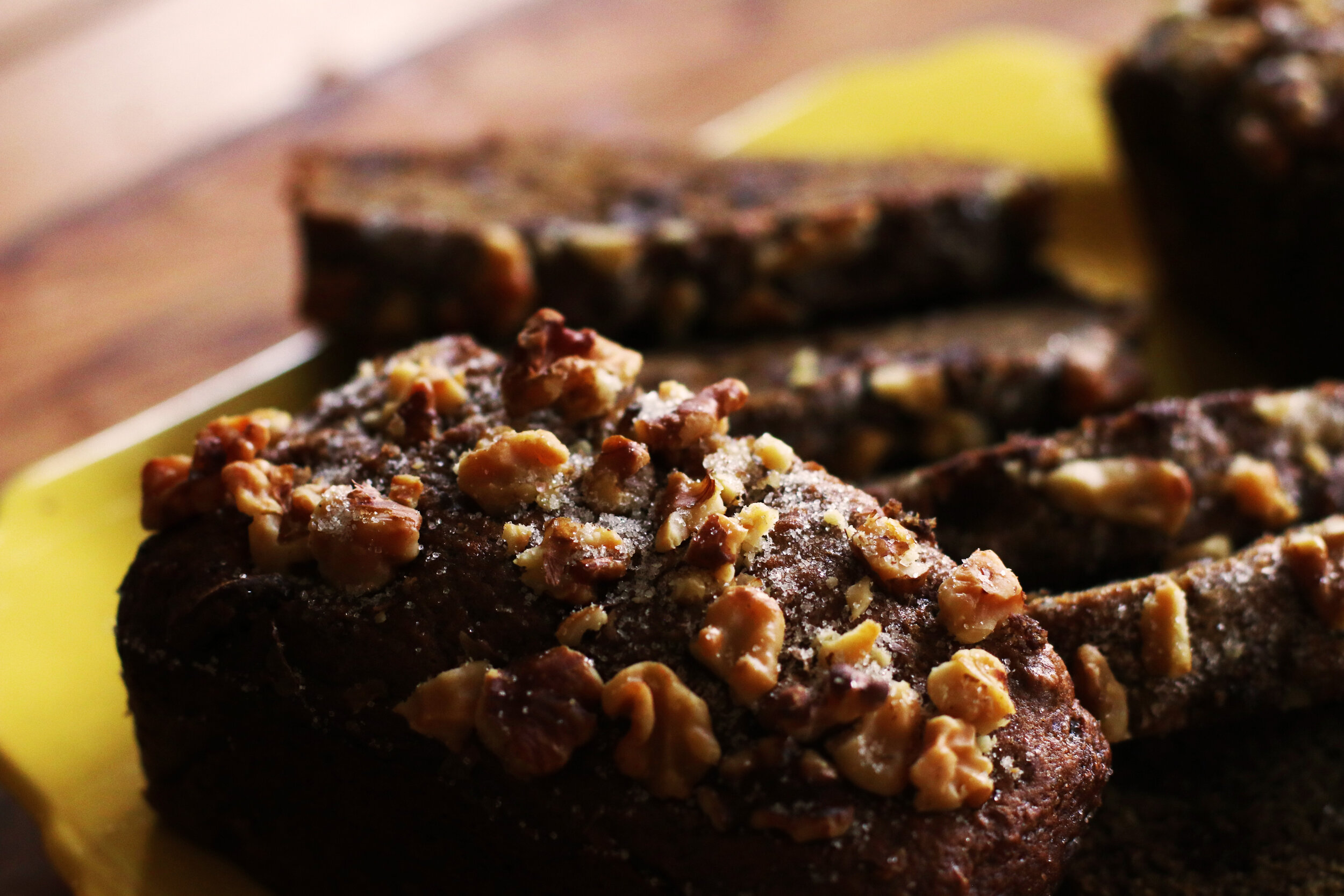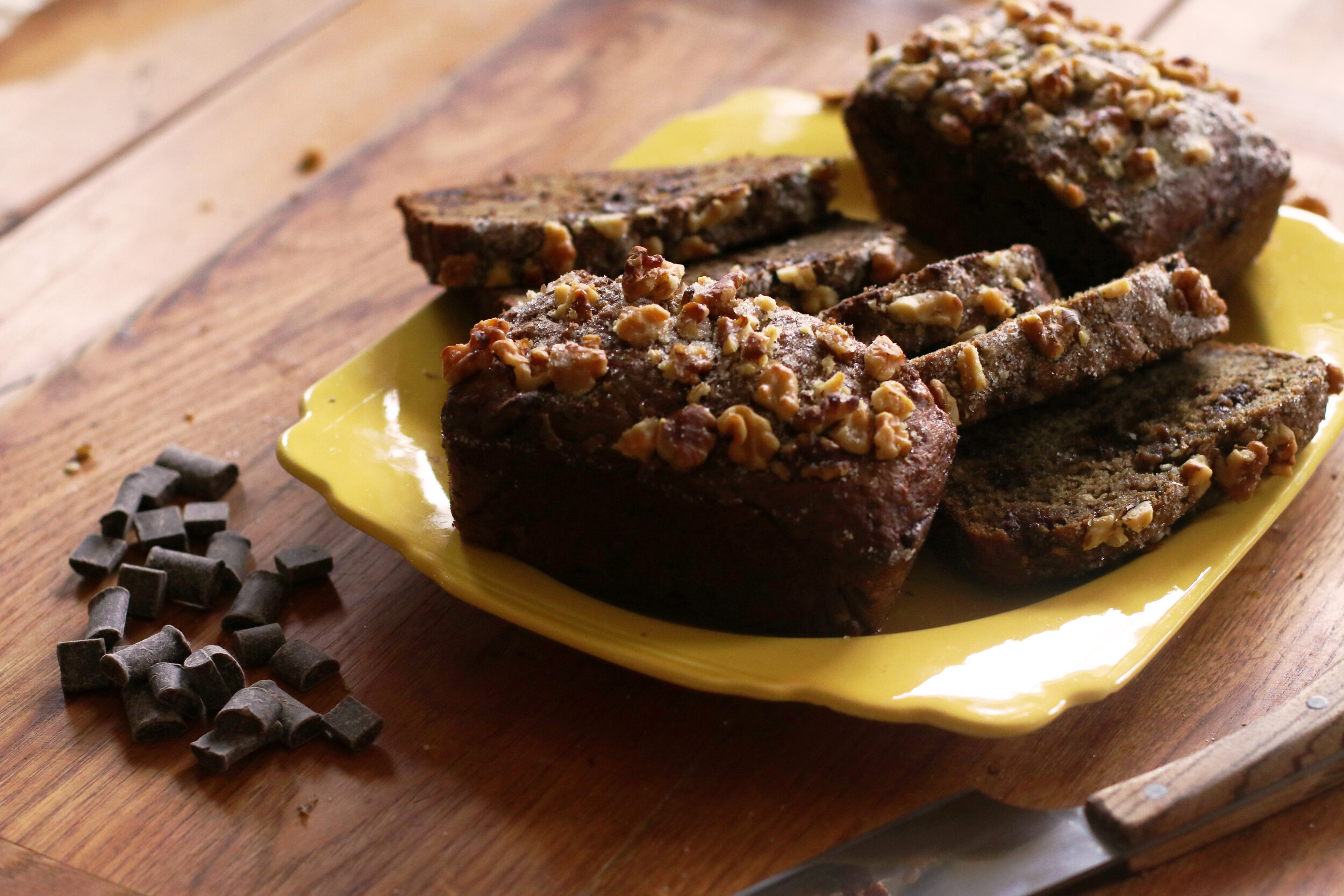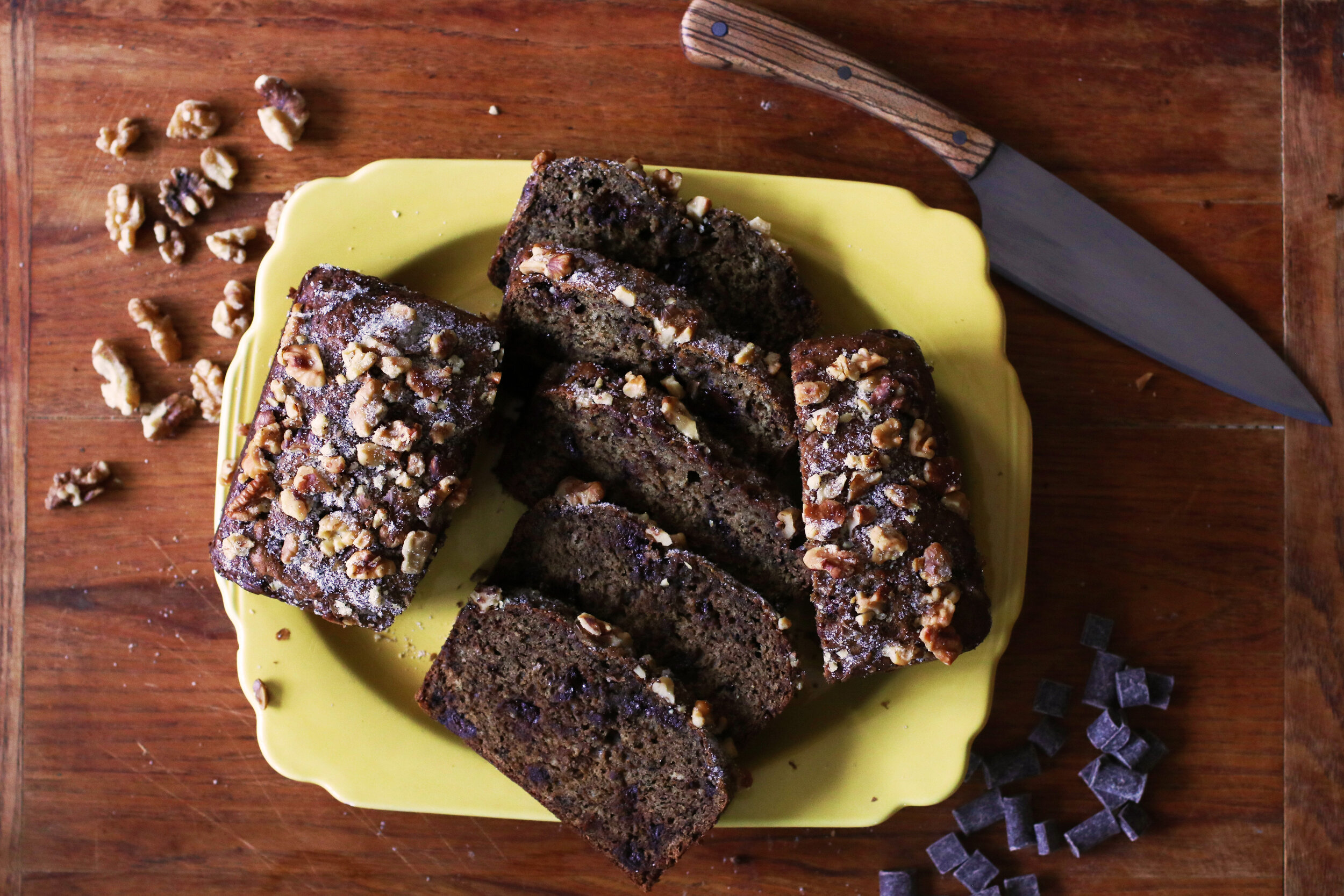Coffee-Chocolate-Chip Banana Bread
I have made this recipe more times than I’m willing to admit. Breakfast potlucks, picnics, dinner-desert, a snack to pick at all week, somehow this banana bread just always works. Also, since most of the ingredients are basic baking staples, this recipe is so easy to throw together when you realize those bananas you bought last week haven’t been touched and are standing on their last leg. It’s a blessing in disguise! Those spotty, semi-blacked, softer-than-you-care-to admit bananas are not only useable, but the ideal candidate for a sweet, rich, and moist (yeah I said ‘moist’) banana bread. If you skipped the chocolate chips and coffee, you’d still end up with a fantastic banana bread, but come on, why would you do that. Rich pockets of chocolate dispersed throughout, a complexity and nuttiness offered by the coffee infusion, and crunchy and sweet walnut topping, what more could you want.
Reworking this recipe for Grounded Grub, we had to confront one of the important ingredients, butter. We avoid supporting the cows-milk dairy industry for a huge variety of reasons. That being said, there are certainly circumstances in which the small-scale local dairy producer is offering you a product that could easily be considered more sustainable than the palm oil butter alternative you might err toward. So, we decided to put the ingredient to the test. We made one batch with butter from a local producer, and one batch with a butter alternative produced with sustainable ingredients. The result? We found only a marginal difference in the overall flavor and consistency. The real-butter version was every-so-slightly richer and moister. That, however can be easily adjusted for. So, our recommendation is this. If you are choosing between a small-scale local producer of butter and a butter alternative that uses a heavy-impact oil like palm oil, go with your local producer. But if that local producer is absent, we recommend trying the butter alternative. We used Miyoko’s European Style Cultured Vegan Butter because its primary ingredient is coconut oil, but there are certainly other options that offer both flavor and sustainable ingredients!
Note: this recipe was inspired by Bobby Flay’s Banana Bread Recipe, shout out to Bobby Flay!
Ingredients
5 tbsp Unsalted Butter (or 6tbsp of Butter-Alternative) : plus extra to grease up your bread pan
1 tbsp Instant Espresso/Coffee : The instant espresso/coffee is preferred as the “grounds” are made to be consumed. If you are unable to get this ingredient, you can use actual coffee grounds as well! However, you will need to strain the grounds out of the butter-mixture before adding the mixture to your batter
1 tsp Baking Soda
1/4 tsp Kosher Salt : plus extra for finishing
4 Ripe Bananas : These should be at the very least beginning to develop brown/black spots. However, if they are completely blacked, you probably have a spoiled banana, so ideally something in between!
2 cups Granulated Sugar : plus extra for the sugar-coated top
2 tbsp Lightly-Packed Brown Sugar
1 Egg
1.5 cups All-purpose Flour
3-4 oz semi-sweet chocolate chunks : I prefer large chunks of chocolate, so I chopped mine into roughly 1cm squares.
1/4 cup Walnuts : chopped into roughly 1cm pieces
Preparation
Preheat your oven to 350ºF
Add your butter to a small sauce pan or pot on medium-low heat and stir gently. If after a minute or so your butter isn’t bubbling at all, your heat is too low, if its rapidly foaming, your heat is too high. If you are using instant coffee/espresso, wait until your butter has developed a dark golden-brown color and then add in your instant coffee/espresso and mix quickly to try and dissolve as much of the grounds as possible. If you are using normal coffee grounds, add them to your butter just as its beginning to develop color and whisk well for an additional 1-2 minutes. If you are using instant coffee/espresso, simply transfer your butter mixture to small bowl and let cool. If you are using normal coffee grounds, strain your grounds out of the butter mixture (this may take several passes) and then transfer to small bowl and let cool.
In a large bowl, whisk together your flour, baking soda, and salt
In a separate large bowl, add your peeled bananas and mash them until you get a relatively smooth mixture. Add in the sugars, the cooled butter mixture, and your egg and whisk until well combined.
Add your dry ingredients (flour mixture) to your wet ingredients and carefully whisk everything together. Be careful not to over-mix, its okay if there are small streaks/pockets of flour.
Add your chocolate chunks to the batter and mix just until they’re well incorporated.
Grease the inside of your bread pan, and if you have it, line the inside with a sheet of parchment paper (the parchment paper isn’t explicitly required, but there’s virtually no chance that you will experience any stick-age if you include it). Pour your batter into the pan, making sure its relatively level.
Take the first 10-15 minutes of baking to chop your walnuts and toss them into a pan on medium-low heat. You want to keep these moving and take them off the heat to cool once they become fragrant. The toasting allows much of their natural oils to be released, making them more aromatic and flavorful, however, if you over-toast them they can easily burn and become bitter.
After roughly 10-15 minutes have passed, remove the bread pan, press the chopped walnuts into the top of the banana bread (it should still be quite soft and pliable) and dust the top of the banana bread with a thin layer of granulated sugar. Place the pan back in the oven.
After roughly 35 minutes have passed, begin to check on your bread. Inserting a toothpick into the bread is one way to do this, if the bread is done baking, the toothpick should come out relatively clean (though you may end up hitting a pocket of chocolate which may make the bread look like it needs more time than it does, so a couple small pokes can help you be sure). The total bake time can be anywhere from 40-50 minutes.
Once the baking is done, remove from the oven and let cool for 30 minutes to an hour. Once its cooled, remove from the pan, slice, and enjoy!
Best Practice:
As always:
Avoid packaged produce, or really anything packaged for that matter. This is not to say that you’ll always have the option, but when you do, go for it! For example, you may sometimes see heavily-plastic-wrapped bananas. These are typically available without any packaging, so take the opportunity to use your hands, smell the produce, build that relationship with your ingredients! That being said, the nuts and baking ingredients may be available in bulk in some areas, but might be difficult to avoid packaging depending on stores close to you. Pick your battles and fight them well!
Try to bring your own bags when you go shopping for these ingredients
Make sure you’re not buying more than you think you’ll reasonably use! Things like flour, sugars, baking soda, coffee, and chocolate chunks will all last a while, so with those if you buy a bit more than you needed, you’ll have plenty of time to use them in the future. But with the Bananas, those will go bad fairly quickly so buy with care!
These ingredients have been chosen with several things in mind:
Most of these ingredients are household staples that are relatively inexpensive and last a long time.
Banana bread capitalizes on our ability to avoid waste by saving an ingredient that might no longer be desirable to eat by itself, but its fantastic when transformed in a recipe like this. If you are able to compost the peels after making the bread, that’s awesome too!
Many of the ingredients in this recipe can not be purchased locally or in-season in many parts of the world. This means most have a bigger impact on the environment than those ingredients sourced closer to where we live. When you’re able, you can purchase these ingredients organic, Fair Trade or locally processed, and they will have a more positive impact on the communities where they are produced. Also, this recipe could be adapted with other fruit you have in abundance. If you give it a try, will you let us know how it goes?
In the beginning of the recipe, we briefly discussed butter and its alternatives : Reworking this recipe for Grounded Grub, we had to confront one of the important ingredients, butter. We avoid supporting the cows-milk dairy industry for a huge variety of reasons. That being said, there are certainly circumstances in which the small-scale local dairy producer is offering you a product that could easily be considered more sustainable than the palm oil butter alternative you might err toward. So, we decided to put the ingredient to the test. We made one batch with butter from a local producer, and one batch with a butter alternative produced with sustainable ingredients. The result? We found only a marginal difference in the overall flavor and consistency. The real-butter version was every-so-slightly richer and moister. That, however can be easily adjusted for. So, our recommendation is this. If you are choosing between a small-scale local producer of butter and a butter alternative that uses a heavy-impact oil like palm oil, go with your local producer. But if that local producer is absent, we recommend trying the butter alternative. We used Miyoko’s European Style Cultured Vegan Butter because its primary ingredient is coconut oil, but there are certainly other options that offer both flavor and sustainable ingredients!
We did not specify a brand or source of chocolate chips to use, however most of the chocolate you will find is made with cows-milk. There are fantastic non-dairy alternatives and we recommend you go out and give them a try! Look for Fair Trade when possible and remember, every little bit counts.
Did you try this recipe? Tag @groundedgrub on instagram or facebook and hashtag it #groundedgrub!





